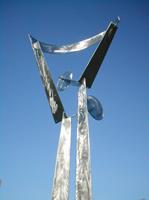
Bryn Mawr College

 |
Center Bryn Mawr College | 
|
April 3
Yu-Tian Wong
Dancing Bodies, Pedagogy and Technology
In discussion, it was suggested that Yu-Tian's scenario also described quite well what happens weekly in physics labs: searching for the "right demonstration," one finds oneself choosing "old stuff that works better but is not as flashy" as newer material. What is the impact in classrooms of such decisions, which are always compromises, always limited by what commercial outputs produce? How can we "move away from the center" in what we show our students, if we are bound to what is commercially viable, if the availability of material is determined by marketability, by what publishers decide we can buy off the shelf?
Our students are "the video generation"; it makes sense to start with the sorts of experiences they are used to, then invite them into more dynamic engagements. Mention was made, however, of the "Brittany Spear effect" (of superstar popularity), the "sneakernet" dynamic of trading and copying music CDs, and the power law distribution of weblogs discussed recently in the Emergence Systems Forum: the cascade effect of the massive disparity in popularity between the most and least visited sites.
A second significant issue involves the authenticity of things shown in class; videotapes, when available, are "better than nothing," but they should not be mistaken for the experience of actually seeing performances. There is a "big canonical shift" in theater studies now to text-based work, which is more accessible, but a totally different experience than performance. Teaching videos (in the form of software stick figures that are obvious abstractions) are also available, but they lack the personal dynamic quality of live performance. The performing body is more volatile and unpredictable, more idiosyncratic than can be captured fully in any recording, on any instrument. If documentary films are used in class, they need to be discussed in terms of their narrative format. When we use videos, or texts, the students may mistakenly think they have been given "the real thing," rather than simply one version, limited in scope.
Scientific images circulate similarly: a set of ideas and concepts, defined by the images which represent them, are fetishized in high school courses, where students are trained to see certain visual metaphors, rather than natural objects themselves. In our classes, we are trying to give them tools and access to "the real thing," to the sort of "good transactions" we ourselves had when we were younger, but the representations we use have a life of their own that is often incorrect. In trying to script for our students the "real experience" that each of us when we first encountered our object of study, we are not actually inviting them into a genuine encounter (see Walker Percy's 1954 essay on "The Loss of the Creature" for a meditation on this theme).
Discussion turned next to the different ways in which the "oxymoron of intellectual property" is handled in science and humanities. Why does Einstein's theory of relativity, for instance, pose no problem in intellectual property when used as a demonstration in class? Why do creative art works differ in this regard? It was explained that choreography is sometimes recorded in notation, other times simply remembered and passed down orally: how can it be copywrighted? When is a gesture not replicable without its inventor's permission? Each artistic performance is different and unique, while scientific ideas are both very well known and reliable BECAUSE replicable. Science understands itself as a process of discovery, in contradistinction to the arts, which are understood as a process of creation and innovation. Science also understands itself as hierarchical, building a-symmtrically and uni-directionally on past work; this too differs from the arts, which reach in two directions, both back to what is old and forward to what is new.
The questions concerning us here also circle back to the same issue which bedeviled us last week: that of money. Is it because scientists are so "vastly overfunded" that issues of "stealing" are less valid concerns among them than they are among artists? What determines when an scientific or artistic product is a script or its product? (Mention was made here of the making of piano rolls, which can be "punched by someone who hears the music in his head.") We don't learn the performance that scientists are doing behind the scenes; we don't share our rehearsal techniques (such as ways of setting up a laser bench). But scientists DO perform (reference had been made, in an earlier discussion, to a colleague in science, who was told by a student that she looked like she was "dancing" when she lectured).
The conversation is already continuing on the On-Line Forum . where it has been asked why science is mostly concerned with teaching canonical ideas and less concerned with its margins than is, say, dance.
Discussion will resume in person next Thursday, April 10, when Catherine Conybeare, of the Classical Studies Department, will lead us in talking about "'Scientia' and 'Cultura': The Origins and Development of These Words." For two semesters we've been discussing various permutations of culture, science, the culture of science, the science of culture. Now, as the year draws to a close, it is time to examine our terms. Are the meanings of "culture" and "science" self-evident? If not, what presuppositions are bound up with them? Catherine will examine the use through time of the two terms, and how their connotations have shifted dramatically. "Science," in particular, turns out to be crucially bound up with notions of how to legitimate intellectual activity and of how it relates to the body.
Home
| Calendar | About
| Getting Involved
| Groups | Initiatives | Bryn Mawr Home | Serendip Home
Director: Liz McCormack -
emccorma@brynmawr.edu
| Faculty Steering Committee
| Secretary: Lisa Kolonay
© 1994-
, by Center for Science in Society, Bryn Mawr College and Serendip
Last Modified:
Wednesday, 02-May-2018 11:57:05 CDT